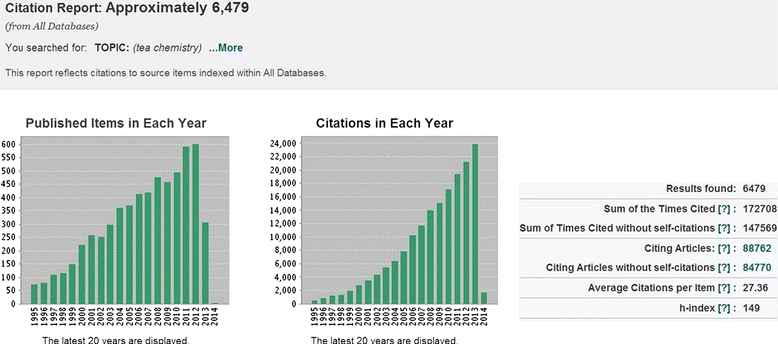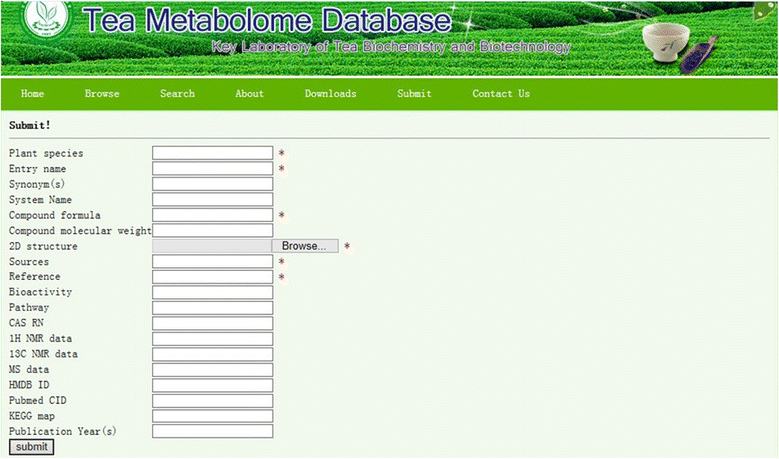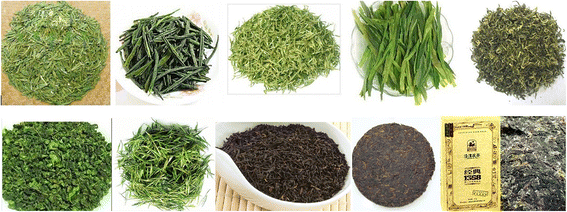TMDB: a literature-curated database for small molecular compounds found from tea
- PMID: 25224438
- PMCID: PMC4172869
- DOI: 10.1186/s12870-014-0243-1
TMDB: a literature-curated database for small molecular compounds found from tea
Abstract
Background: Tea is one of the most consumed beverages worldwide. The healthy effects of tea are attributed to a wealthy of different chemical components from tea. Thousands of studies on the chemical constituents of tea had been reported. However, data from these individual reports have not been collected into a single database. The lack of a curated database of related information limits research in this field, and thus a cohesive database system should necessarily be constructed for data deposit and further application.
Description: The Tea Metabolome database (TMDB), a manually curated and web-accessible database, was developed to provide detailed, searchable descriptions of small molecular compounds found in Camellia spp. esp. in the plant Camellia sinensis and compounds in its manufactured products (different kinds of tea infusion). TMDB is currently the most complete and comprehensive curated collection of tea compounds data in the world. It contains records for more than 1393 constituents found in tea with information gathered from 364 published books, journal articles, and electronic databases. It also contains experimental 1H NMR and 13C NMR data collected from the purified reference compounds or collected from other database resources such as HMDB. TMDB interface allows users to retrieve tea compounds entries by keyword search using compound name, formula, occurrence, and CAS register number. Each entry in the TMDB contains an average of 24 separate data fields including its original plant species, compound structure, formula, molecular weight, name, CAS registry number, compound types, compound uses including healthy benefits, reference literatures, NMR, MS data, and the corresponding ID from databases such as HMDB and Pubmed. Users can also contribute novel regulatory entries by using a web-based submission page. The TMDB database is freely accessible from the URL of http://pcsb.ahau.edu.cn:8080/TCDB/index.jsp. The TMDB is designed to address the broad needs of tea biochemists, natural products chemists, nutritionists, and members of tea related research community.
Conclusion: The TMDB database provides a solid platform for collection, standardization, and searching of compounds information found in tea. As such this database will be a comprehensive repository for tea biochemistry and tea health research community.
Figures






Similar articles
-
TBC2health: a database of experimentally validated health-beneficial effects of tea bioactive compounds.Brief Bioinform. 2017 Sep 1;18(5):830-836. doi: 10.1093/bib/bbw055. Brief Bioinform. 2017. PMID: 27387194 Free PMC article.
-
PASmiR: a literature-curated database for miRNA molecular regulation in plant response to abiotic stress.BMC Plant Biol. 2013 Mar 1;13:33. doi: 10.1186/1471-2229-13-33. BMC Plant Biol. 2013. PMID: 23448274 Free PMC article.
-
HMDB: the Human Metabolome Database.Nucleic Acids Res. 2007 Jan;35(Database issue):D521-6. doi: 10.1093/nar/gkl923. Nucleic Acids Res. 2007. PMID: 17202168 Free PMC article.
-
A review on human fecal metabolomics: Methods, applications and the human fecal metabolome database.Anal Chim Acta. 2018 Nov 7;1030:1-24. doi: 10.1016/j.aca.2018.05.031. Epub 2018 May 12. Anal Chim Acta. 2018. PMID: 30032758 Review.
-
Plant Resources, Chemical Constituents, and Bioactivities of Tea Plants from the Genus Camellia Section Thea.J Agric Food Chem. 2019 May 15;67(19):5318-5349. doi: 10.1021/acs.jafc.8b05037. Epub 2018 Dec 3. J Agric Food Chem. 2019. PMID: 30449099 Review.
Cited by
-
TBC2health: a database of experimentally validated health-beneficial effects of tea bioactive compounds.Brief Bioinform. 2017 Sep 1;18(5):830-836. doi: 10.1093/bib/bbw055. Brief Bioinform. 2017. PMID: 27387194 Free PMC article.
-
Integrated transcriptomics and metabolomics analysis of catechins, caffeine and theanine biosynthesis in tea plant (Camellia sinensis) over the course of seasons.BMC Plant Biol. 2020 Jun 29;20(1):294. doi: 10.1186/s12870-020-02443-y. BMC Plant Biol. 2020. PMID: 32600265 Free PMC article.
-
Defense against oxidative stress in Caenorhabditis elegans by dark tea.Front Vet Sci. 2024 Jan 5;10:1342747. doi: 10.3389/fvets.2023.1342747. eCollection 2023. Front Vet Sci. 2024. PMID: 38249557 Free PMC article.
-
Tea plant genomics: achievements, challenges and perspectives.Hortic Res. 2020 Jan 1;7:7. doi: 10.1038/s41438-019-0225-4. eCollection 2020. Hortic Res. 2020. PMID: 31908810 Free PMC article. Review.
-
LC-ESI-QTOF/MS characterization of antimicrobial compounds with their action mode extracted from vine tea (Ampelopsis grossedentata) leaves.Food Sci Nutr. 2022 Jan 19;10(2):422-435. doi: 10.1002/fsn3.2679. eCollection 2022 Feb. Food Sci Nutr. 2022. PMID: 35154679 Free PMC article.
References
-
- Ulrich HE. 3.23 Chemistry of Tea, Comprehensive Natural Products II Chemistry and Biology. Oxford, United Kingdom: Elsevier Ltd; 2010. pp. 999–1032.
-
- Wheeler DS, Wheeler WJ. The medicinal chemistry of tea. Drug Dev Res. 2004;61(2):45–65. doi: 10.1002/ddr.10341. - DOI
Publication types
MeSH terms
Substances
LinkOut - more resources
Full Text Sources
Other Literature Sources
Research Materials
Miscellaneous

